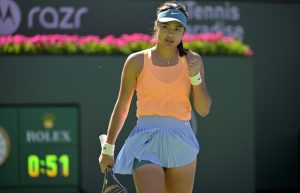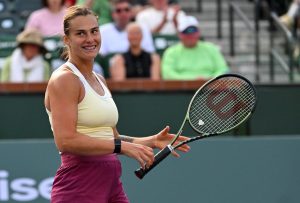The great Don Budge, one of only two men to complete the Calendar Grand Slam, said Helen Wills was the greatest female tennis player ever. The director and actor Charlie Chaplin went even further, claiming that watching her move around a tennis court was the most beautiful thing he had ever seen. Haig Patigian, the renowned Armenian-American sculptor, made a bust of her that was simply called ‘Helen of California’, as if to suggest she was the equal of her ancient namesake, Helen of Troy.
These are just three testaments to the singular skill, beauty and sheer majesty of Wills (still known to many by married name of Wills Moody), undoubtedly one of the greatest players and most important figures in the history of tennis. Wills was born in the city of Centerville (now called Fremont), which is near San Francisco, in 1905. Like so many of the early pioneers of tennis, notably “The Big Two” of Bill Tilden and Suzanne Lenglen, her parents were wealthy and so were able to encourage and fund her early interest in tennis.
She was eight when her father first bought her a tennis racket and she began playing the game by facing him on the dirt courts near the hospital where he worked as a physician. That idyllic existence was interrupted by America’s entry into the First World War in 1917, when her father was deployed to France. Fortunately for Wills, and for the sport she would excel at, her father survived, and when he returned to California afterwards he relocated his family to Berkeley, the famous university city.
Wills spent the rest of her childhood and her early adult life there, first at a private school and then at the university itself, where she proved she was not only a skilled sportswoman but also a gifted scholar, as she won an academic, not a sporting scholarship, to attend Berkeley. Nevertheless, despite her keen interest in her academic studies, Wills continued to play tennis, joining the Berkeley Tennis Club when she was 12.
There, she honed her instinctive tennis skills, in particular her elegant and apparently effortless movement around the court, in spite of the long and flowing dresses that women played in at the time. Berkeley Tennis Club was one of the most prestigious in America, as illustrated by the fact that so many famous former stars of the game played and coached there. That proved to be to Wills’ advantage in the years to come.
In the summer of 1920, when she was still only 13, Wills was able to play with the celebrated Hazel Hotchkiss Wightman, one of the leading lights of American tennis before the First World War and who the annual team competition between American and British women, the Wightman Cup (which ran from 1923 to 1989), was named for. Wills unsurprisingly benefited from seeing Wightman at such close quarters, with her exposure to Wightman surely helping her to replace the older woman as the poster girl of American women’s tennis.
In 1921, aged just 16, Wills won both the singles and doubles titles at the California State Championships. This state-level triumph soon propelled her onto the national and then the international stage. She competed for the USA at the 1924 Olympics in Paris, again winning both the singles and doubles titles, with Wills equally accomplished in both disciplines. Indeed, Wills would go on to win 12 Major doubles and mixed doubles titles, alongside the extraordinary 19 Major singles titles she collected.
Wills’ domination of women’s tennis between the two World Wars began in earnest at the US Championships in 1923, when she was still only 18. She defeated a fellow American, the marvellously named Molla Mallory 6-2 6-1, in the final, having dismissed another of her compatriots, Eleanor Goss, in similarly decisive fashion in the semifinals. It was a sign of things to come for Wills, who made it a hat-trick of wins at the US Championships by returning to claim the title in 1924 and 1925.
Then, for good measure, she repeated the trick (or rather hat-trick) by winning another three titles in succession between 1927 and 1929. Two years later, she added a seventh title in 1931, which made it seven titles in eight years for Wills. In fact, only the aforementioned Mallory, who won a remarkable eight titles between 1915 and 1926 (including defeating Wills in her first ever Major final in 1922), has won more women’s singles titles at the US Championships/Open.
However, Mallory’s successes were limited to her home Major. In contrast, Wills eventually extended her dominance across the Atlantic Ocean. At Wimbledon, she eventually enjoyed even more success than she had in her native US, winning a total of eight Wimbledon singles titles between 1927 and 1938, including four titles in a row between 1927 and 1930. Incredibly, she also won a hat-trick of French singles titles between 1928 and 1930, and then won again in Paris in 1932.
This remarkable annexation of both the greatest clay court tournament in the world and the greatest grass court tournament in the world, despite the completely different surfaces and demands that they impose on players, has never been matched by any woman ever, and was only ever rivalled by Björn Borg’s excellence on clay and grass nearly half a century later, when he won five Wimbledon singles titles in a row between 1976 and 1980 and six French Open titles between 1974 and 1981.
If there is a hole in Wills’ resume, it is that she played France’s Suzanne Lenglen, the one woman capable of rivalling her dominance, just once and in a match that was not even at a Major. Instead, their only clash was effectively an exhibition match, played at the celebrated Carlton Club in Cannes in February 1926, when Lenglen was at (or perhaps just beyond) the peak of her powers and Wills was fast approaching hers.
But, although the match was nominally just an exhibition, it was still a classic, with Lenglen winning 6-3 8-6 after a truly titanic second set. In fact, Wills forced a set point to take the match to a third and deciding set and claimed for the rest of her life that she had won it. Unfortunately, Wills was forced to withdraw from both the French Championships and Wimbledon that year with appendicitis, whilst 1926 proved to be Lenglen’s last season as an amateur.
As a result, the two finest women players of the interwar years never met on court again, and a Lenglen-Wills rematch became one of the greatest tennis matches that never happened. But one suspects that this did not weigh too heavily on Wills. In Lenglen’s absence from the amateur game, Wills continued her dominance, winning a total of 19 Major singles titles before she finally retired, a record that stood for more than three decades until Margaret Court finally surpassed it in the 1970s.
That statistic alone is proof of her greatness, but as with so many of the very best tennis players, from Lenglen herself to Roger Federer today, there was also an irresistible aesthetic component to Wills’ game that elevated her above mere statistical success. Wills was always admired for her grace and fleetness of foot, which Chaplin wrote of admiringly in his 1964 autobiography.
In fact, Chaplin, a tennis devotee who continued to play with and support Bill Tilden, even after his infamous fall from grace, also often played Wills, especially after she retired in 1938 following her eighth and last Wimbledon singles triumph. Their relationship was sufficiently close, and Chaplin so completely charmed by her game, that legend has it that he considered including her in one of his films.
That never came to pass, which is made an even greater loss by the fact that so little footage of Wills at her absolute peak survives today, barring brief newsreels of her Major triumphs, especially at Wimbledon. Fortunately, such was her unique combination of balletic movement and bullet shots that her place in the history and, arguably more importantly, the mythology of tennis is utterly secure.
Suffice it to say that if the alluring Jordan Baker, the golf star and flapper who so dazzled Nick Carraway in The Great Gatsby, had played tennis rather than golf, she would surely have looked exactly like Wills. Indeed, Wills might almost be thought of as a female equivalent of Gatsby himself, the enduring female symbol of the Jazz Age, the interwar era when tennis first captured the global sporting and artistic imagination.
Main photo:
Embed from Getty Images






